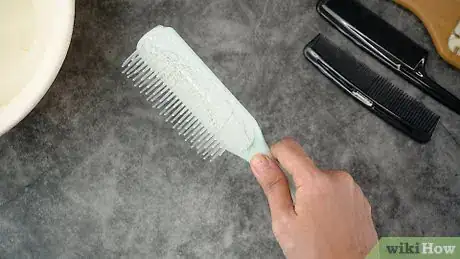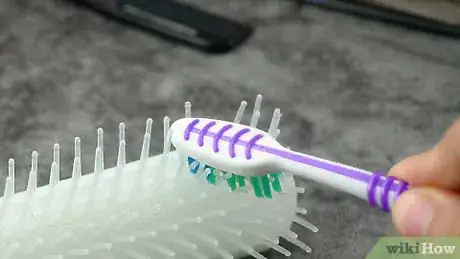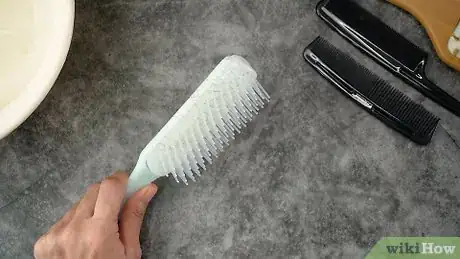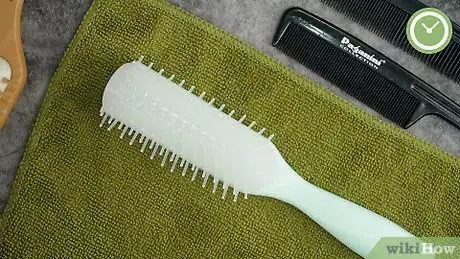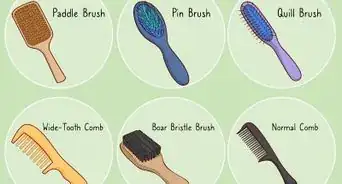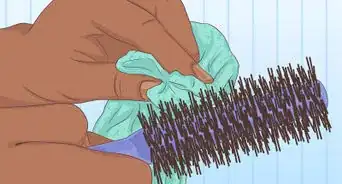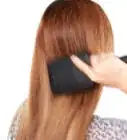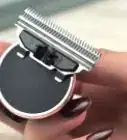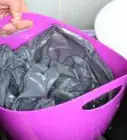This article was co-authored by Kana Ishii and by wikiHow staff writer, Janice Tieperman. Kana Ishii is a Licensed Cosmetologist in the US and Japan, currently based in Beverly Hills. With more than 18 years of experience, she specializes in hair styling and coloring services such as balayage. Her work has been featured in Elle Girl Magazine, Cosmopolitan Magazine, and Modern Salon Magazine. She has also worked at major events, including The Academy Awards. Kana has won several hair competitions at some of the biggest beauty expos in the world such as the International Salon and Spa Expo and the Premier Orlando International Beauty Event.
There are 14 references cited in this article, which can be found at the bottom of the page.
This article has been viewed 58,190 times.
Hair tends to build up in the bristles of your hairbrushes, which might look gross but is easy to remedy. You can quickly remove the hair by hand or using a comb, then wash your brush with shampoo to get rid of any gunk that remains. Your brush will be hair-free and clean in just a few minutes.
Steps
Removing Hair from Plastic Spikes
-
1
-
2Soak the brush under running water. If your brush consists of plastic spikes instead of bristles, you may have trouble picking the hair out by hand. Place it under running water for about 10 seconds to help to loosen the hair stuck in your brush.[3]Advertisement
-
3Remove the wet hair from the brush with your fingers. Now that the loose hair is wet, you should be able to pull most of it out in one go. If you’re having trouble getting a good grasp on the clumps, try pinching the hair with your fingers.[4]
- Don’t be discouraged if you can't pull all of the hair off at once.
-
4
Cleaning Hair out of Bristles
-
1
-
2Use a small plastic comb to remove any loose hair. Select a comb with small teeth. Hold the comb in your opposite hand and run it through the brush. It does not matter if you use vertical or horizontal strokes, as long as you remove the hair. With a bristle brush, this process should feel similar to combing through normal hair.[9]
- If the hair isn’t coming out with the comb alone, consider using the comb to push the loose hair towards the top of the bristles. This will make it easier to pull out by hand.
-
3Remove the hair with your fingers. If you are having trouble removing any of the hair from your brush, use your fingers to pinch and remove any excess strands. It may be easier if you use your fingertips to secure the hair and pull it from the brush.[10]
Washing the Brush
-
1Fill a small container with warm water. Find a small bowl or plastic container that will fit your brush. Using warm water, fill this container about halfway full. You want to make sure that your brush will be fully immersed during the cleaning process.[11]
-
2Soak the brush to remove any hair or skin. Clasp the handle of your brush in one hand and dip it into the container of water. Spin the brush around in the water so that all of the bristles or plastic spikes are soaked.[14] Do this for a few seconds, or until you’re confident that the brush is free of any hair or skin.[15]
-
3Squeeze a few drops of shampoo onto a toothbrush. Take your shampoo bottle and coat the surface of the toothbrush with shampoo. While you can use your own shampoo for this, you want to make sure that the product won’t be too harsh on the brush.[16]
- Consider using baby shampoo for the cleaning process.[17]
-
4Rub the shampoo around the bristles. Use short, round motions to rub the toothbrush over the surface of the brush. While you don’t want to break your brush, use enough force so you thoroughly clean all of the plastic spikes and/or bristles.[18]
- Use caution when cleaning a brush with a wooden handle or a soft bottom pad. These parts can be damaged if they’re exposed to a lot of water.[19]
-
5Rinse off the brush in running water. It doesn’t matter if the water is warm or cool. Rinse and spin the brush until you’re confident that all of the shampoo suds have been rinsed out.[20]
-
6Let the brush dry overnight. Lay the brush on a clean towel after you have rinsed it off. Put the brush face-down on the towel so it can drain easily. Leave the hairbrush there to dry throughout the night.[21]
- Don’t store the brush until it has dried completely. You don’t want mildew to form over time and ruin the brush.
Things You’ll Need
- Toothbrush
- Plastic comb
- Shampoo
- Bowl or small container
References
- ↑ https://www.realsimple.com/beauty-fashion/hair/tools-techniques/clean-hairbrush
- ↑ https://m.youtube.com/watch?v=-XSL-CgxZYM&t=0m10s
- ↑ https://m.youtube.com/watch?v=-XSL-CgxZYM&t=0m50s
- ↑ https://m.youtube.com/watch?v=-XSL-CgxZYM&t=0m56s
- ↑ https://m.youtube.com/watch?v=-XSL-CgxZYM&t=1m15s
- ↑ https://m.youtube.com/watch?v=-XSL-CgxZYM&t=1m11w
- ↑ https://www.realsimple.com/beauty-fashion/hair/tools-techniques/clean-hairbrush
- ↑ https://m.youtube.com/watch?v=Iuq5Zal180k&0m1s
- ↑ https://m.youtube.com/watch?v=Iuq5Zal180k&0m28s
- ↑ https://m.youtube.com/watch?v=-XSL-CgxZYM&t=0m55s
- ↑ https://m.youtube.com/watch?v=Iuq5Zal180k&1m01s
- ↑ https://m.youtube.com/watch?v=Iuq5Zal180k&t=1m01s
- ↑ Kana Ishii. Licensed Cosmetologist. Expert Interview. 22 December 2021.
- ↑ Kana Ishii. Licensed Cosmetologist. Expert Interview. 22 December 2021.
- ↑ https://www.realsimple.com/beauty-fashion/hair/tools-techniques/clean-hairbrush
- ↑ https://www.realsimple.com/beauty-fashion/hair/tools-techniques/clean-hairbrush
- ↑ https://www.apartmenttherapy.com/baby-shampoo-uses-265067
- ↑ https://m.youtube.com/watch?v=-XSL-CgxZYM&t=1m13s
- ↑ https://www.realsimple.com/beauty-fashion/hair/tools-techniques/clean-hairbrush
- ↑ https://www.realsimple.com/beauty-fashion/hair/tools-techniques/clean-hairbrush
- ↑ https://www.realsimple.com/beauty-fashion/hair/tools-techniques/clean-hairbrush
